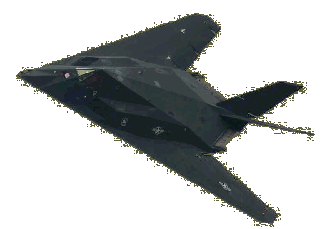Clearly showing the “stealth shape”, the F-117 Nighthawk was created in total secrecy
by Lockheed Martin’s “Skunk Works” division. For nearly two decades the Nighthawk
conducted testing and development at a secret location in the Nevada desert. The
aircraft is technically a ground attack aircraft and should be called the A-117 but
was given the F or fighter designation. There are many theories of why it was given
the false designation but most sources concur that it was to mislead the Soviet Union.
The US Air Force denied the existence of the Nighthawk until 1988 when a grainy
photo of the plane surfaced. Then in 1990, two Nighthawks landed at Nellis AFB to
waiting crowds.
In 1991, the opening night of Operation Desert Storm heralded the first time the
Nighthawk saw action and it performed better than expected. Invisible to all enemy
radar, the Nighthawk was able to bring its payload to the target without fear of
enemy surface to air missiles and other radar guided anti-aircraft. While it only
comprised about 3% of the total coalition forces, it was hit 35% of the first night’s
targets. After Operation Desert Storm, the Nighthawk was found to have hit over
75% of all of its targets, an astonishing record for any aircraft. With that the
Nighthawk was also credited with keeping an 82% MC rate, or mission-capability rate.
This showed that the Nighthawk was not only deadly but also reliable.
The Nighthawk gave designers at Lockheed the platform to test new technologies
that were incorporated in the F-22 Raptor and F-35 Joint Strike Fighter. These new
aircraft have also heralded the end of the Nighthawk. In 2007 the F-117 was scheduled
for retirement and on March 11, 2008 the last two Nighthawks flew their last mission
to Tonopah Test Range Airport where they were dismantled and stored in the hangers
that housed when they were still a black project.




